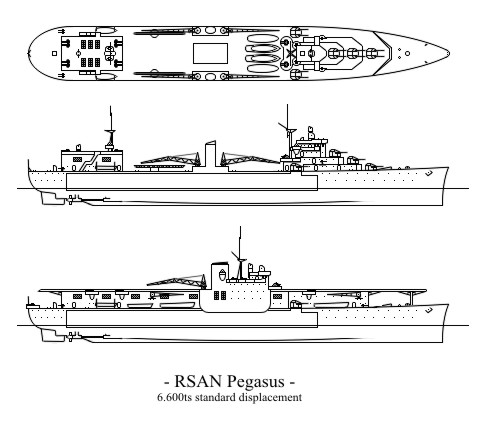Is she worth it? Meant to act as fleet scout and escort for minor fleet operations.
CVL36A, South African Light Fleet Carrier laid down 1936
Displacement:
9.645 t light; 9.928 t standard; 10.835 t normal; 11.560 t full load
Dimensions: Length overall / water x beam x draught
589,67 ft / 574,15 ft x 65,62 ft x 19,36 ft (normal load)
179,73 m / 175,00 m x 20,00 m x 5,90 m
Armament:
8 - 4,53" / 115 mm guns (4x2 guns), 46,40lbs / 21,05kg shells, 1936 Model
Breech loading guns in deck mounts with hoists
on centreline ends, evenly spread, all raised mounts - superfiring
8 - 1,57" / 40,0 mm guns (4x2 guns), 1,95lbs / 0,89kg shells, 1936 Model
Anti-aircraft guns in deck mounts
on side, evenly spread, all raised mounts
8 - 0,79" / 20,0 mm guns (4x2 guns), 0,24lbs / 0,11kg shells, 1936 Model
Machine guns in deck mounts
on side, evenly spread, 3 raised mounts
Weight of broadside 389 lbs / 176 kg
Shells per gun, main battery: 300
Armour:
- Gun armour: Face (max) Other gunhouse (avg) Barbette/hoist (max)
Main: 1,38" / 35 mm 0,98" / 25 mm 1,38" / 35 mm
3rd: 0,59" / 15 mm - -
4th: 0,39" / 10 mm - -
- Armour deck: 1,97" / 50 mm
Machinery:
Oil fired boilers, steam turbines,
Geared drive, 2 shafts, 93.833 shp / 70.000 Kw = 32,09 kts
Range 7.000nm at 15,00 kts
Bunker at max displacement = 1.631 tons
Complement:
530 - 690
Cost:
£3,939 million / $15,755 million
Distribution of weights at normal displacement:
Armament: 49 tons, 0,4%
Armour: 962 tons, 8,9%
- Belts: 0 tons, 0,0%
- Torpedo bulkhead: 0 tons, 0,0%
- Armament: 31 tons, 0,3%
- Armour Deck: 931 tons, 8,6%
- Conning Tower: 0 tons, 0,0%
Machinery: 2.633 tons, 24,3%
Hull, fittings & equipment: 3.601 tons, 33,2%
Fuel, ammunition & stores: 1.190 tons, 11,0%
Miscellaneous weights: 2.400 tons, 22,2%
Overall survivability and seakeeping ability:
Survivability (Non-critical penetrating hits needed to sink ship):
11.605 lbs / 5.264 Kg = 250,1 x 4,5 " / 115 mm shells or 1,5 torpedoes
Stability (Unstable if below 1.00): 1,14
Metacentric height 3,4 ft / 1,0 m
Roll period: 15,0 seconds
Steadiness - As gun platform (Average = 50 %): 51 %
- Recoil effect (Restricted arc if above 1.00): 0,09
Seaboat quality (Average = 1.00): 1,02
Hull form characteristics:
Hull has a flush deck
Block coefficient: 0,520
Length to Beam Ratio: 8,75 : 1
'Natural speed' for length: 23,96 kts
Power going to wave formation at top speed: 59 %
Trim (Max stability = 0, Max steadiness = 100): 50
Bow angle (Positive = bow angles forward): 25,00 degrees
Stern overhang: 3,28 ft / 1,00 m
Freeboard (% = measuring location as a percentage of overall length):
- Stem: 26,25 ft / 8,00 m
- Forecastle (20%): 19,36 ft / 5,90 m
- Mid (45%): 19,36 ft / 5,90 m
- Quarterdeck (25%): 19,36 ft / 5,90 m
- Stern: 19,36 ft / 5,90 m
- Average freeboard: 19,91 ft / 6,07 m
Ship tends to be wet forward
Ship space, strength and comments:
Space - Hull below water (magazines/engines, low = better): 107,0%
- Above water (accommodation/working, high = better): 177,9%
Waterplane Area: 25.567 Square feet or 2.375 Square metres
Displacement factor (Displacement / loading): 120%
Structure weight / hull surface area: 93 lbs/sq ft or 453 Kg/sq metre
Hull strength (Relative):
- Cross-sectional: 0,97
- Longitudinal: 1,29
- Overall: 1,00
Hull space for machinery, storage, compartmentation is adequate
Room for accommodation and workspaces is excellent


